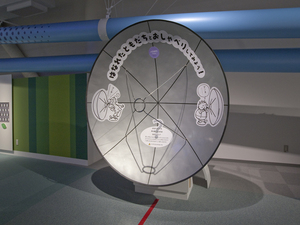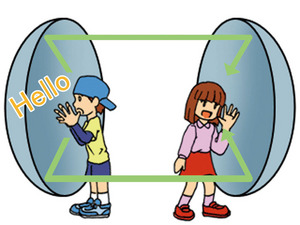Nagoya City Science Museum
TOP > Exhibition Guide > Keyword Search > Starting with "P" > Physics > Parabola
Parabola



Purpose of Exhibition
Things that look like big bowls are installed on the wall opposite in the exhibition room. These are parabolic sound collectors. The reason why the sound reaches the other side clearly even if you speak with a tiny voice is because the sound is reflected without diffusion.
Additional Knowledge
No matter how loudly you speak, it is very difficult to reach by voice a person located 100 meters away.
This is because of the extension of the sound (voice) in every direction, therefore it doesn't reach the person directly. In addition, it is also known that when you cup your hands over your mouth and speak like a megaphone, your voice reaches the person more clearly. In other words, if you collect sound as it is and let it travel toward one direction, you can transmit sound effectively. It is the principal of the parabola. Parabola refers to parabola in mathematics.
From now, we will introduce a little advanced mathematics story.
We study quadratic function in third grade of junior high school. Everybody knows that if you write a quadratic function on a graph, the curve will be a parabola.
Put an arbitrary point A inside of this parabola. Draw a straight line l from here parallel to Y axis and set an intersection B with the parabola. Draw a line tangent m on point B of the parabola and draw a line n through point B and perpendicular to line m. Furthermore, as this line n is an axis, draw a symmetrical line l and set intersection C with Y axis. Then, wherever you put point A which was set first, point C on the Y axis is always set in the same position. This point C is called the focus of the parabola. In other word, when making a paraboloid surface and receiving sound that travels parallel to the axis, sound reflects on the paraboloid surface and it can be collected all in one point. On the other hand, the sound that was made from a focus position to paraboloid surface reflects by the paraboloid surface and travels parallel in an axial direction. Thus, it is possible to collect sound and electric waves that spread all around and deliver them in one place. Therefore, parabola is used for receiving antennas of satellite broadcasting and international transmitters and receivers.
In the exhibited parabola, the focus position is shown with a small ring. Let's speak here with a small voice. If your friends move their ear closer to the position of the parabola ring of the other side, they will be able to hear the sound surprisingly well.
By the way, why is there not much interference in conversation, even if there are obstacles (for example, other visitors) between parabolas? Low frequency waves (long wavelength) such as the voice has the ability to turn around obstacles. Therefore, even if there are obstacles, waves travel to the reception side parabola and the voice reaches there. This going-around characteristic is called diffraction.
However, in the case of high frequency (short wavelength) radio waves, it is not the same. This is the reason why electric television waves with high frequency don't reach hidden regions in the mountain so easily as compared with electric radio waves.
Article by: Koichi Mabuchi, curator
